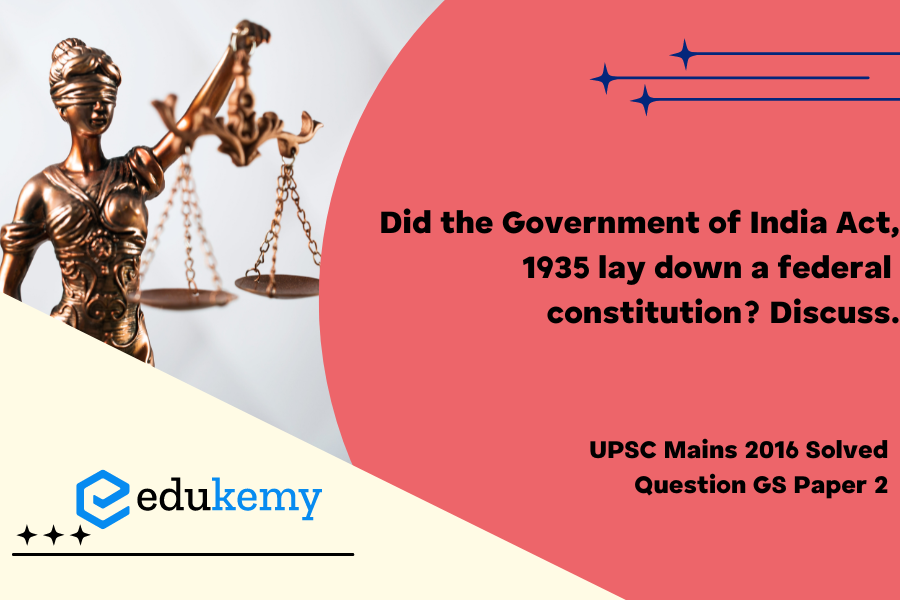The Government of India Act, of 1935, marked a significant turning point in the constitutional history of British India, as it aimed to introduce comprehensive reforms in the governance of the subcontinent. However, the pivotal question surrounding its provisions is whether it effectively established a federal constitution. While the Act incorporated elements that resembled federal features, such as the division of powers between the central and provincial governments, it fell short of constituting a true federal structure. The Act granted significant powers to the Viceroy and the Governor-General, diminishing the autonomy of the provinces. Moreover, the hierarchical and centralized nature of the legislative and executive authority, coupled with the existence of an overriding authority vested in the British Parliament, undermined the federal spirit. The federal provisions of the Act were marred by complexities, ambiguities, and a lack of clarity, leading to a system that was more unitary in practice. This essay will delve into the key features of the Government of India Act, of 1935, critically assessing whether it genuinely laid down the foundations of a federal constitution or if its structural flaws perpetuated a quasi-federal arrangement in the governance of British India.
Tag: Indian Constitution—historical underpinnings, evolution, features, amendments, significant provisions, and basic structure.
Contents
Decoding the Question:
- In the Introduction, try to briefly write about the Govt. of India Act 1935 and federalism.
- In the Body, discuss the provisions of the Act related to the federal structure.
- In Conclusion, try to mention its failure and link it with the present Constitution.
Answer:
The Government of India Act 1935 was based on the Joint Select Committee, led by Lord Linlithgow, and the white paper resulted from the Round Table conferences. It came into effect in 1937; it provided a framework for the federal government where powers are divided between the Centre and states or provinces.

Federal Features of the Government of India Act, 1935:
- It proposed a federation of British provinces and the Princely States in India. The Princely States had an option to join the Federation.
- The Act provided a bicameral legislature, with the Lower House elected directly, and the Upper House with a composite representation of princely states and affluent classes. The Act also gave more powers to the Upper House (The Council of States) that of voting grants and making ministers responsible to the Council too.
- It divided the powers between the Centre and units in terms of three lists, the Federal List (for the Centre), the Provincial List (for provinces), and the Concurrent List (for both).
- The Act provided a Federal Court to interpret the provisions and to decide over inter-province disputes.
- The principle of Dyarchy, that is, dividing governmental administration into reserved and transferred subjects and treating them differentially, was introduced at the Centre.
- It provided for the establishment of not only a Federal Public Service Commission but also a Provincial Public Service Commission and Joint Public Service Commission for two or more provinces.
- It also carried the essential features of the Federation – a written constitution, division of subjects between federal and provincial governments, and a Federal Court to interpret the provisions of the Constitution.
Not a true federal system:
- Discretionary powers: The new act armed the governors and governor-general with tremendous discretionary powers and thus reduced provincial autonomy on paper. In a way the Act made the Governors so powerful that they could play the dictator if they liked. The Governors and the Governor-General continued to have the last word in the preparation of the budget and allocation of funds to various departments.
- Legislation regarding the provincial list: The Federal Legislature had the power to legislate concerning the subjects enumerated in the Provincial List if a proclamation of emergency was made by the governor-general.
- Defective Federation: The proposed formation of the Federation was also fundamentally defective. Entry into the federation was compulsory for the Provinces but voluntary for the Princely States. There were a lot of differences regarding population, area, political importance, and status between the provinces and the States. Whereas the British Provinces were partly autonomous units, the States were still under the autocratic rule of the Princes.
- Residuary powers: The allocation of residuary powers was unique. It was not vested in either of the legislatures, central or provincial. But the Governor-General was empowered to authorize, either the Federal or the Provincial Legislature to enact a law concerning any residuary matter.
The 1935 Act was aimed at perpetuating British rule and designed to appease Nationalists. The act also had regressive provisions such as a separate electorate and had divide and rule as its guiding philosophy. An analysis of the features concludes that despite the provision to draft a federal Constitution, the Government of India Act fell short of an actual federal Constitution.
In case you still have your doubts, contact us on 9811333901.
For UPSC Prelims Resources, Click here
For Daily Updates and Study Material:
Join our Telegram Channel – Edukemy for IAS
- 1. Learn through Videos – here
- 2. Be Exam Ready by Practicing Daily MCQs – here
- 3. Daily Newsletter – Get all your Current Affairs Covered – here
- 4. Mains Answer Writing Practice – here


